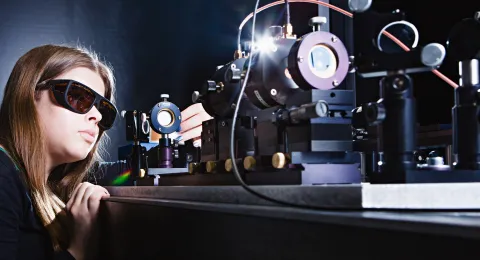The research strives to improve the quality of materials and industrial measurement systems e.g. by developing sensors and related information transfer electronics, such as fibre optic links. The laboratory has also launched international cooperation in research and education on a large scale with e.g. CERN.

Magnetic semiconductors
Our unit has a long tradition in magnetic semiconductor research. Our research focuses mainly on II-V and II-IV-V semiconductors doped with magnetic impurities, and our unit is one of the leading groups in this narrow area.
We have developed an analytical method for transport phenomena, Hall voltage, and resistivity research results, and we are also investigating the suitability of these materials for spintronics applications.
Our new research topic is carbon nanoparticles in which interesting ferromagnetic behavior has been observed.
Superconductors - a new promise of green technology
For superconductors, our unit has focused on investigating the order parameter symmetry in Pnictide superconductors and high temperature superconductors (HTSC). Pnictide superconductors are a new group of superconductors whose order parameter symmetry is studied by computational methods. The research also aims to obtain more information about the electrical conductivity of Pnictide superconductors in strong magnetic fields.
Semiconductor detectors and CERN cooperation
In the field of semiconductor detectors, our group works closely with the European Center for Particle Research (CERN). CERN's activities are at the forefront of particle physics, and operations in Finland are coordinated in co-operation between the University of Helsinki, Aalto University, the University of Jyväskylä, the University of Tampere and Lappeenranta University of Technology.
The main goal of the CMS experiment is to produce new discoveries in particle physics, but at the same time to do hardware development work to enable the experiments. Our team has manufactured more than 2,000 optical link cards for the CMS trigger station, and is also actively involved in the development of MIGFET transistors and 3D Stripixel detectors.
Our unit is also researching the UTDR (Ultrasound time domain reflectometry) method.
Research
Studies

Master's Programme in Applied Physics
In this master's programme, you will become an expert in applied, industrial, and experimental physics.

The ELMO-LION
ELMO-LION is a new European battery technology and innovation 6 ECTS Credit PhD course and a Summer School which is funded by EIT Raw Materials in the field of Li-ion batteries.
Our staff

Bernardo Barbiellini

Nurfikri Bin Norjoharuddeen











